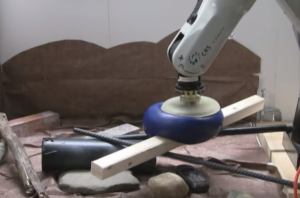
Is the World ready for the New Frontier of Robotic End of Arm Tooling?
Maxx Wright | 01 November 2016
In light of the recent 50th anniversary of the beloved super-saga, Star Trek, it is only appropriate that the Bastian Solutions blog once again breaks the barrier of common blog posts and explores only the weirdest and most alien of material handling technology.
That’s right, End of Arm Tooling - those unsettling, dangling, space-age looking apparatuses that seem to grow on the end of the robotic arms seen in so many facilities today. Discussions of safe and repeatable technologies are all great, but what about the stuff that scares the daylights out of the conventional players in this field? What about those special material handling projects that require real “Trekky” thinking? I mean, what if someone wants to move silly putty around, or only acquire half a stack of paper?
Many of the concepts being developed to meet these potential demands may only exist on a small scale or in research labs, but if the field of industrial robotics continues to evolve the way it has over the last 20 years, the newest innovations will begin to make their way into designs as requests for increasingly versatile and flexible robotic solutions only become more demanding.
Flexible Diaphragm End of Arm Tooling
 “Jamming” was a term coined in 2012 to describe the process of constricting multiple solid particles, using a flexible diaphragm, while the particles conform to any object that is pressed into the flexible surface. This would cause any object currently presenting an edge to the “jammer” to be tightly acquired when air is forcibly removed from the diaphragm surrounding the solid particles.
“Jamming” was a term coined in 2012 to describe the process of constricting multiple solid particles, using a flexible diaphragm, while the particles conform to any object that is pressed into the flexible surface. This would cause any object currently presenting an edge to the “jammer” to be tightly acquired when air is forcibly removed from the diaphragm surrounding the solid particles.
This type of gripper is not prejudiced by any means; it can be gentle enough to handle fragile items and does not need to differentiate between products being obtained. Mostly actuated by vacuum, these rounded end of arm tools would be particularly useful in a robotic application that requires retaining objects of various shapes and orientation. Several roadblocks still exist in this technology, however, like the nearly tenth of a second it takes to effectively grip a surface.
Electroadhesion Technology
 Electroadhesion is another exciting, space-age technology that is beginning to find its way into industrial applications - not only in end of arm tooling, but also in nearly vertical conveyor infused with static energy to better hold product set on its surface.
Electroadhesion is another exciting, space-age technology that is beginning to find its way into industrial applications - not only in end of arm tooling, but also in nearly vertical conveyor infused with static energy to better hold product set on its surface.
This technology utilizes high voltage to create an electrostatic force that induces opposing charges in any material it comes into contact with. The opposite polarities create a strong attraction and the materials bind together. Essentially, two pieces of non-conductive material can snap together much like the concept of magnetism. The material that houses the conductive strips conveying voltage can be flexible, flat, concave, or really any shape that is required to properly approach an object.
In addition, this effect can be turned on and off in the same way as flipping a switch, like a lightbulb. Requiring just a fraction of the power and complexity required for suction-based systems, while still performing many of the same functions, this technology is positioned to be very disruptive in the world of industrial end effectors. As with all the new technologies, electroadhesion will need careful calibration as many factors (such as surface area, dust buildup and material composition) play into the amount of weight that can be handled and effect the speed at which an electroadhesive device can properly adhere to a surface.
Electroactive Polymer End of Arm Tooling
 Finally, Electroactive Polymers must be mentioned in this article as well since they are, by far, the most theoretical concept. Even though the technology is in its infant stages, it offers some interesting advantages as you consider the ability to change the conformation of a physically imposing material simply by applying an electrical pulse.
Finally, Electroactive Polymers must be mentioned in this article as well since they are, by far, the most theoretical concept. Even though the technology is in its infant stages, it offers some interesting advantages as you consider the ability to change the conformation of a physically imposing material simply by applying an electrical pulse.
If a raw piece of a plastic-like polymer could instantly change its shape and suddenly assume a 90 degree angle, varying items of substantial weight could be instantly secured and easily handled. This technology is not that far off and will, someday, revolutionize the material world as rigid constructs actuate with a single line of code.
Some of these concepts sound out of this world and should be restricted to interesting television shows, but, at the end of the day, these new technologies provide good food for thought and will continue to inspire breakthroughs that will allow material handling to increase in speed and capability. As this rapidly diversifying field continues to demand more innovation, there will be more and more crazy, techy ideas that seem to come right out of a Star Trek re-run – and maybe they did.
Comments
No comments have been posted to this Blog Post
Leave a Reply
Your email address will not be published.
Comment
Thank you for your comment.